
Royal Botanic Gardens, Kew, is a non-departmental public body in the United Kingdom sponsored by the Department for Environment, Food and Rural Affairs. An internationally important botanical research and education institution, it employs 1,100 staff. Its board of trustees is chaired by Dame Amelia Fawcett.

Bignoniaceae is a family of flowering plants in the order Lamiales commonly known as the bignonias. It is not known to which of the other families in the order it is most closely related.

Goldenrod is a common name for many species of flowering plants in the sunflower family, Asteraceae, commonly in reference to the genus Solidago.
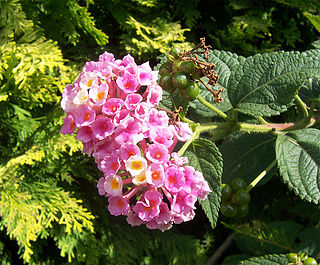
The Verbenaceae are a family — the verbena family or vervain family — of mainly tropical flowering plants. It contains trees, shrubs, and herbs notable for heads, spikes, or clusters of small flowers, many of which have an aromatic smell.

Hepatica is a genus of herbaceous perennials in the buttercup family, native to central and northern Europe, Asia and eastern North America. Some botanists include Hepatica within a wider interpretation of Anemone.
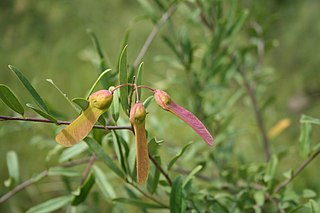
The Polygalaceae or the milkwort family are made up of flowering plants in the order Fabales. They have a near-cosmopolitan range, with about 21 genera and ca. 900 known species of herbs, shrubs and trees. Over half of the species are in one genus, Polygala, the milkworts.

Myrica is a genus of about 35–50 species of small trees and shrubs in the family Myricaceae, order Fagales. The genus has a wide distribution, including Africa, Asia, Europe, North America and South America, and missing only from Australia. Some botanists split the genus into two genera on the basis of the catkin and fruit structure, restricting Myrica to a few species, and treating the others in Morella.

Azorella is a genus of flowering plants in the family Apiaceae, native to South America, New Zealand, southeastern Australia, and the islands of the Southern Ocean.

Selenicereus, sometimes known as moonlight cactus, is a genus of epiphytic, lithophytic, and terrestrial cacti, found in Mexico, Central America, the Caribbean and northern South America. The term night-blooming cereus is also sometimes used, but this is also used for many night-blooming cacti, including Epiphyllum and Peniocereus. In 2017, the genus Hylocereus was brought into synonymy with Selenicereus. A number of species of Selenicereus produce fruit that is eaten. The fruit, known as pitaya or pitahaya in Spanish or as dragon fruit, may be collected from the wild or the plants may be cultivated.

Calandrinia is a large genus of flowering plants known as purslanes and redmaids. It includes over 100 species of annual and perennial herbs which bear colorful flowers in shades of red to purple and white. Plants of this genus are native to Australia, western South America, Central America, and western North America. Some species have been introduced to parts of New Zealand, southern Africa, Asia, and Europe.

Colletia is a genus of flowering plants in the family Rhamnaceae, with 5 species of spiny shrubs. All species of this genus are native to southern South America. They are non-legume nitrogen fixers.

Danthonia is a genus of Eurasian, North African, and American plants in the grass family. Members of this genus are sometimes referred to as oatgrass, but that common name is not restricted to this genus. Other common names include heathgrass and wallaby grass. Australian species have since been reclassified into the genera Austrodanthonia and Rytidosperma.

Erechtites is a genus of flowering plants in the daisy family known commonly as fireweeds or burnweeds. They are native to the Americas and Australia, but some species are widely distributed weeds.

Anarthrophyllum is a genus of flowering plants in the legume family, Fabaceae. It belongs to the subfamily Faboideae.
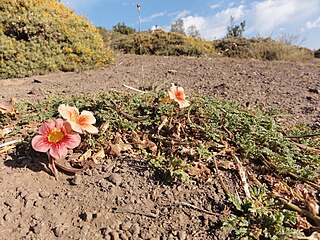
Argylia adscendens is a species of perennial plant in the family Bignoniaceae. It is found in Chile.

Argylia uspallatensis is a species of perennial plant in the family Bignoniaceae. It is found in Chile and Argentina.

Argylia radiata is a species of perennial plant in the family Bignoniaceae. It is found in Brazil, Chile, and Peru.
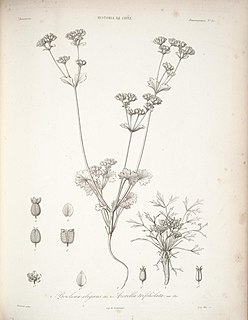
Homalocarpus is a genus of flowering plants in the family Apiaceae, found in Chile. They are annual herbs with white, yellow, red or purple flowers.
Gamocarpha is a genus of flowering plants in the family Calyceraceae, native to the Andes of Chile and Argentina. It has been proposed to synonymize the genus Nastanthus within Gamocarpha.
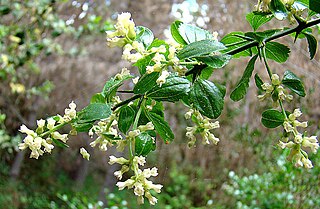
Retanilla is a genus of flowering plants in the family Rhamnaceae, native to Chile, Peru, and Argentina. The species in this genus are actinorhizal plants.



















